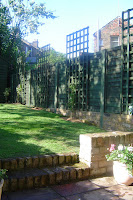My compost bin is part of the fence dividing my 'garden' garden from my 'allotment' garden. In the limited space of a town garden these are the decisions you have to make - compost bins attract slugs and snails, which is not what you want near your tender veg plants. The advantage is that when the material is well rotted, it's near the veg plot. The one metre square bin is split in two, and household and garden waste (no weeds) goes into one side, then the other.
The bin provides a good backdrop to plants on the flowerbed side, and setting some bricks into the soil makes a nice path, favoured by all neighbourhood cats. I hope they enjoy hunting any rats that may be lurking. In fact our most recent ex-cat is enjoying it too, since I had to inter Pepper under the bricks, as other unbricked locations attracted too much attention.
In summer months the compost gives off a mild odour, which is only noticeable when you stand very near it. The nearest you get to it in passing is about a metre, or three feet in old money. Inevitably, it attracts insects to do vital work, but these are kept down by scattering straw over the top of the active compost every few weeks.
Experts talk about well rotted compost being like used tea leaves. This seems very unlikely, when you're chucking slops of this and that into the void, and inhaling that acrid smell. Still, the compost I dug out at the weekend was just like dense, fine used tea leaves. Within the solid tea leaf-y mass were egg shells, wine corks, avocado skins like thin brittle leather and dessicated but unrotted split avocado pips. And teaspoons. No babies have been thrown out with the bathwater so far in this house, but teaspoons are at constant risk. They survive better than the wooden pestle I discovered in the last batch of compost I made, which looks gently scalloped, as though made out of driftwood.
Some of the compost has been dug into a trench, awaiting the French beans. The rest will be used over the summer.
The bin provides a good backdrop to plants on the flowerbed side, and setting some bricks into the soil makes a nice path, favoured by all neighbourhood cats. I hope they enjoy hunting any rats that may be lurking. In fact our most recent ex-cat is enjoying it too, since I had to inter Pepper under the bricks, as other unbricked locations attracted too much attention.
In summer months the compost gives off a mild odour, which is only noticeable when you stand very near it. The nearest you get to it in passing is about a metre, or three feet in old money. Inevitably, it attracts insects to do vital work, but these are kept down by scattering straw over the top of the active compost every few weeks.
Experts talk about well rotted compost being like used tea leaves. This seems very unlikely, when you're chucking slops of this and that into the void, and inhaling that acrid smell. Still, the compost I dug out at the weekend was just like dense, fine used tea leaves. Within the solid tea leaf-y mass were egg shells, wine corks, avocado skins like thin brittle leather and dessicated but unrotted split avocado pips. And teaspoons. No babies have been thrown out with the bathwater so far in this house, but teaspoons are at constant risk. They survive better than the wooden pestle I discovered in the last batch of compost I made, which looks gently scalloped, as though made out of driftwood.
Some of the compost has been dug into a trench, awaiting the French beans. The rest will be used over the summer.















